
The USTTA Historic Library
- film restoration -
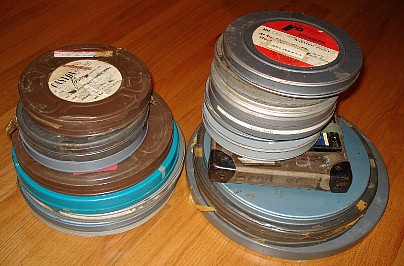
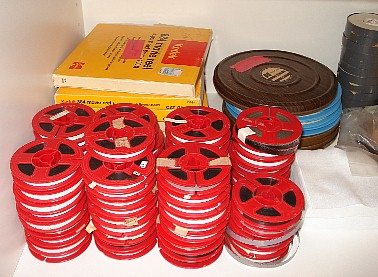 The USTTA film library, lost for decades, has been (mostly) recovered.
It consists of about a dozen 16mm films, and countless 8mm home videos.
They range in condition from excellent to rough, as they were frequently
"checked out" and used by private individuals on various projection
equipment.
The USTTA film library, lost for decades, has been (mostly) recovered.
It consists of about a dozen 16mm films, and countless 8mm home videos.
They range in condition from excellent to rough, as they were frequently
"checked out" and used by private individuals on various projection
equipment.
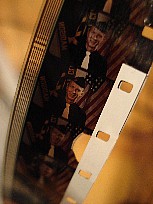 Before film can be played, it needs to be checked by hand, cleaned,
and any splices repaired. In some cases, I have found it useful to
repair sprocket holes using special purpose tape (shown at the right).
Preparing a film for playback can be tedious if the film is badly
damaged, but can make a huge difference in the quality of the transfer.
Before film can be played, it needs to be checked by hand, cleaned,
and any splices repaired. In some cases, I have found it useful to
repair sprocket holes using special purpose tape (shown at the right).
Preparing a film for playback can be tedious if the film is badly
damaged, but can make a huge difference in the quality of the transfer.
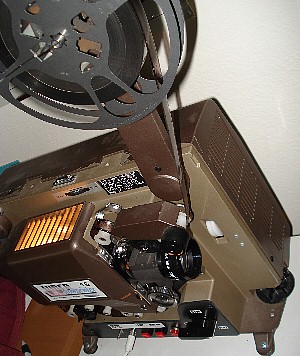 Once prepared, digitizing and restoring old film can be done in a number of
ways. One of the best ways is to use a Workprinter. These are
projectors which have been modified to communicate directly with a computer,
using a 3-CCD camera to capture each frame individually. The process
is slow - 6 frames per second - but the quality far exceeds ordinary
direct projection methods.
Once prepared, digitizing and restoring old film can be done in a number of
ways. One of the best ways is to use a Workprinter. These are
projectors which have been modified to communicate directly with a computer,
using a 3-CCD camera to capture each frame individually. The process
is slow - 6 frames per second - but the quality far exceeds ordinary
direct projection methods.
The Workprinter I use is made by Roger Evans of the
company Moviestuff,
and is shown on the left. Although it may look like a standard projector,
it is actually much more. Connections with the computer are done via
a special mouse, as shown below. The process works essentially as
follows: (1) the projector advances the film, (2) the image is projected
into the video camera, (3) the projector sends a signal to press the mouse
button on the computer, and (4) the computer software captures the image
and appends it onto the video file. The software used is
called Cinecap.

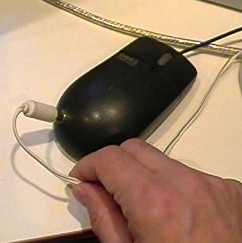


Once captured, the video file generally requires additional attention:
- speed correction
- color correction
- motion stabilization
Speed correction can be done using Cinecap (mentioned above). The remaining
corrections are done either using standard video editing software (such as
Sony Vegas) or by using one of the
many Virtualdub filters available on
the internet. For example, the DeShaker filter by Gunnar Thalin is
particularly good at smoothing jittery video.
 The satisfying part of all of this effort, is that even very old film
can yield beautiful images. Here are a couple of snapshots of frames
taken from 16mm films - one from a 1983 world table tennis championship,
and one from a 1950 drumcorps film. Neither of them have had any adjustment
or correction of any kind!
The satisfying part of all of this effort, is that even very old film
can yield beautiful images. Here are a couple of snapshots of frames
taken from 16mm films - one from a 1983 world table tennis championship,
and one from a 1950 drumcorps film. Neither of them have had any adjustment
or correction of any kind!
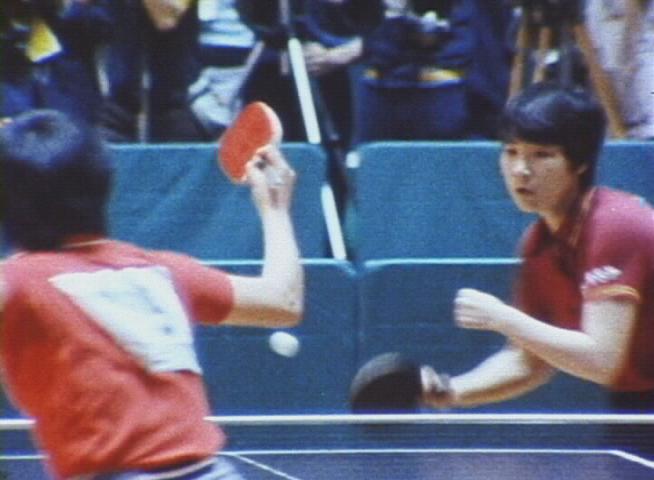
Some of the films are silent, but most include AUDIO. Since the video
is capture frame-by-frame at a slow rate, audio must be captured
separately. This is done using a standard film projector connected
through an audio card to the computer. After transfer, the audio on these
old films also needs considerable attention. There are often loud
thumps whenever a splice or other repairs are present. Synchronization
with the video can be a slow, painstaking task... at times it is even
discovered that the original film was poorly synchronized to begin with!
Final audio mastering is done using a product
called Ozone:

The entire process of cleaning, repairing, capturing, correcting,
synching audio, stabilizing, and encoding can range anywhere from
a couple of hours to several days, depending on the length and condition
of the film. The two disks in the USTTA Historic Table Tennis Films
set reflect several months of effort.
Some problems persist in the films and cannot be repaired.
You may notice the following:
- dropouts - splices and edits often make for sudden jumps.
- audio - optical film audio is often uneven in quality.
- grain - many of these films were amateur efforts, and the resulting films can be grainy.
- color shifting - the 1972 diplomacy film had become SO red, that repair was limited.
- scratches - a wetgate transfer could mask these, but the price would be prohibitive.
I hope that you enjoy these historic treasures in spite of
their blemishes. Each one of them posed unique challenges to restore
them to a condition suitable for home viewing. Watch for future
releases as I work my way through the 8mm library.
-Scott
hardbat homepage
contact: sgordon@hardbat.com
 Before film can be played, it needs to be checked by hand, cleaned,
and any splices repaired. In some cases, I have found it useful to
repair sprocket holes using special purpose tape (shown at the right).
Preparing a film for playback can be tedious if the film is badly
damaged, but can make a huge difference in the quality of the transfer.
Before film can be played, it needs to be checked by hand, cleaned,
and any splices repaired. In some cases, I have found it useful to
repair sprocket holes using special purpose tape (shown at the right).
Preparing a film for playback can be tedious if the film is badly
damaged, but can make a huge difference in the quality of the transfer.


 The USTTA film library, lost for decades, has been (mostly) recovered.
It consists of about a dozen 16mm films, and countless 8mm home videos.
They range in condition from excellent to rough, as they were frequently
"checked out" and used by private individuals on various projection
equipment.
The USTTA film library, lost for decades, has been (mostly) recovered.
It consists of about a dozen 16mm films, and countless 8mm home videos.
They range in condition from excellent to rough, as they were frequently
"checked out" and used by private individuals on various projection
equipment.
 Once prepared, digitizing and restoring old film can be done in a number of
ways. One of the best ways is to use a Workprinter. These are
projectors which have been modified to communicate directly with a computer,
using a 3-CCD camera to capture each frame individually. The process
is slow - 6 frames per second - but the quality far exceeds ordinary
direct projection methods.
Once prepared, digitizing and restoring old film can be done in a number of
ways. One of the best ways is to use a Workprinter. These are
projectors which have been modified to communicate directly with a computer,
using a 3-CCD camera to capture each frame individually. The process
is slow - 6 frames per second - but the quality far exceeds ordinary
direct projection methods.




 The satisfying part of all of this effort, is that even very old film
can yield beautiful images. Here are a couple of snapshots of frames
taken from 16mm films - one from a 1983 world table tennis championship,
and one from a 1950 drumcorps film. Neither of them have had any adjustment
or correction of any kind!
The satisfying part of all of this effort, is that even very old film
can yield beautiful images. Here are a couple of snapshots of frames
taken from 16mm films - one from a 1983 world table tennis championship,
and one from a 1950 drumcorps film. Neither of them have had any adjustment
or correction of any kind!

